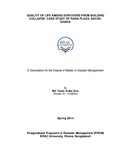Quality of life among survivors from building collapse: case study of Rana Plaza, Savar, Dhaka

View/Open
Date
2014Publisher
BRAC UniversityAuthor
Alve, Md. Yeasir ArafatMetadata
Show full item recordAbstract
The study identifies the quality of life among the survivors of the Rana plaza building
collapse incident at Savar, Dhaka at 2013. It also finds out the association between
demographic factors (age, sex, income, diagnosis) contributing the quality of life
(Physical, psychological social and environmental domain) among the survivors. The
study was conducted through Cross-sectional study design among 92 Rana Plaza
survivors who were selected by purposive comprehensive sampling technique from
CRP data based (Savar) by a structured questionnaire with face to face interview.
World Health Organization Quality of Life Scale- 100 (WHOQOL-100) was used to
conduct the study. In case of, overall quality of life of RANA Plaza survivors, about
42.4% of them have neither poor nor good quality of life; therefore about 19.6% of
them have very poor type of quality of life at the period of 10 months incident. There
was a significant association with survivors’ type of disabilities, diagnosis, current
occupation and their quality of life that means the quality of life is quiet better for
person with temporary disabilities rather than person with permanent disabilities.
Those who are in jobs have good quality of life than unemployed survivors. However,
there are no associations with age, sex, educational background, and amount of
support with their quality of life. Rehabilitation centre like CRP has bounded the
survivors with an integration program, treatments, vocational training etc. It might
become the prime mover for survivors to improve their quality of life at ten months
period of time but no one have very good quality of life. The government and
concerned authorities should come forward to take necessary measures to prevent
any type of manmade disasters like- building collapse, fire etc. through an
appropriate collaboration from top to bottom as well as should develop a sustainable
follow-up system after any disaster.
